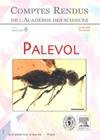德国梅塞尔始新世食肉蜥蜴“Saniwa”feisti Stritzke, 1983的解剖、系统发育关系和解剖学
IF 1.3
4区 地球科学
Q3 PALEONTOLOGY
引用次数: 8
摘要
有鳞食肉动物(沧龙、蛇、巨蜥、吉拉怪)的进化和相互关系是爬行动物系统学中一个有争议的部分,在推断进化史时是形态学和分子数据冲突的核心。在这个混杂的群体中,保存最完好的化石之一是1983年的“Saniwa”feisti Stritzke,它的完整骨架来自德国梅塞尔的始新世早期中期。我们重新描述它的基础上,浅表检查,立体放射照相,和高分辨率的x射线计算机断层扫描新的和已发表的标本。这种蜥蜴的鳞片是独特的,包括头部的小龙骨鳞片(包括一排扩大的内侧眶上鳞片)和覆盖身体其余部分的大菱形龙骨鳞片(由骨皮覆盖)。脖子上有两排纵向排列的扩大鳞片。头部侧向受压,呈盒状,因为存在强大的颞侧脊;四肢和尾巴都很长。显著的骨特征包括:齿状带状突起;隔腋窝具一长后突;眼睑具长后外侧突;一个泪头和一个泪孔;一种发育良好的副半双酚类植物的培养过程;除了迷走神经外还有两个舌下(XII)孔;替代牙缺乏吸收坑;而且可能每个位点都有不止一波的替换牙。没有骨学改变提示下颌内铰链,但在多个标本中发现的角-关节前-角复合体的死后移位表明,基于软组织改变,下颌可能有一定程度的活动。通过对包含473个形态特征和46个DNA位点的数据集进行系统发育分析,我们推断本文章由计算机程序翻译,如有差异,请以英文原文为准。
The anatomy, phylogenetic relationships, and autecology of the carnivorous lizard “Saniwa” feisti Stritzke, 1983 from the Eocene of Messel, Germany
The evolution and interrelationships of carnivorous squamates (mosasaurs, snakes, monitor lizards, Gila Monsters) are a contentious part of reptile systematics and go to the heart of conflict between morphological and molecular data in inferring evolutionary history. One of the best-preserved fossils in this motley grouping is “Saniwa” feisti Stritzke, 1983, represented by complete skeletons from the early-middle Eocene of Messel, Germany. We re-describe it on the basis of superficial examination, stereoradiography, and high-resolution X-ray computed tomography of new and published specimens. The scalation of the lizard is unique, consisting of small, keeled scales on the head (including a row of enlarged medial supraorbitals) and large, rhomboidal, keeled scales (invested by osteoderms) that covered the rest of the body. Two paired longitudinal rows of enlarged scales ran down the neck. The head was laterally compressed and box-shaped due to the presence of a strong canthal-temporal ridge; the limbs and tail were very long. Notable osteological features include: a toothed, strap-like vomer; septomaxilla with a long posterior process; palpebral with a long posterolateral process; a lacrimal boss and a single lacrimal foramen; a well-developed cultriform process of the parabasisphenoid; two hypoglossal (XII) foramina in addition to the vagus; a lack of resorption pits for replacement teeth; and possibly the presence of more than one wave of developing replacement teeth per locus. There are no osteological modifications suggestive of an intramandibular hinge, but postmortem displacement of the angular-prearticular-surangular complex in multiple specimens suggests that there might have been some degree of mobility in the lower jaw based on soft-tissue modifications. Using phylogenetic analyses on a data-set comprising 473 morphological characters and 46 DNA loci, we infer that
求助全文
通过发布文献求助,成功后即可免费获取论文全文。
去求助
来源期刊

Comptes Rendus Palevol
地学-古生物学
CiteScore
2.10
自引率
0.00%
发文量
39
审稿时长
17.6 weeks
期刊介绍:
Comptes Rendus Palevol is a fully electronic and peer-reviewed journal, with a continuous publication stream, devoted to palaeontology, prehistory and evolutionary sciences. It publishes original research results, in French or English, in the following domains: systematic and human palaeontology, prehistory, evolutionary biology and macroevolution, and history of sciences. Thematic issues may also be published under the responsibility of a guest editor. All articles published in Comptes Rendus Palevol are compliant with the different nomenclatural codes. A copyright assignment will be signed by the authors before publication.
 求助内容:
求助内容: 应助结果提醒方式:
应助结果提醒方式:


